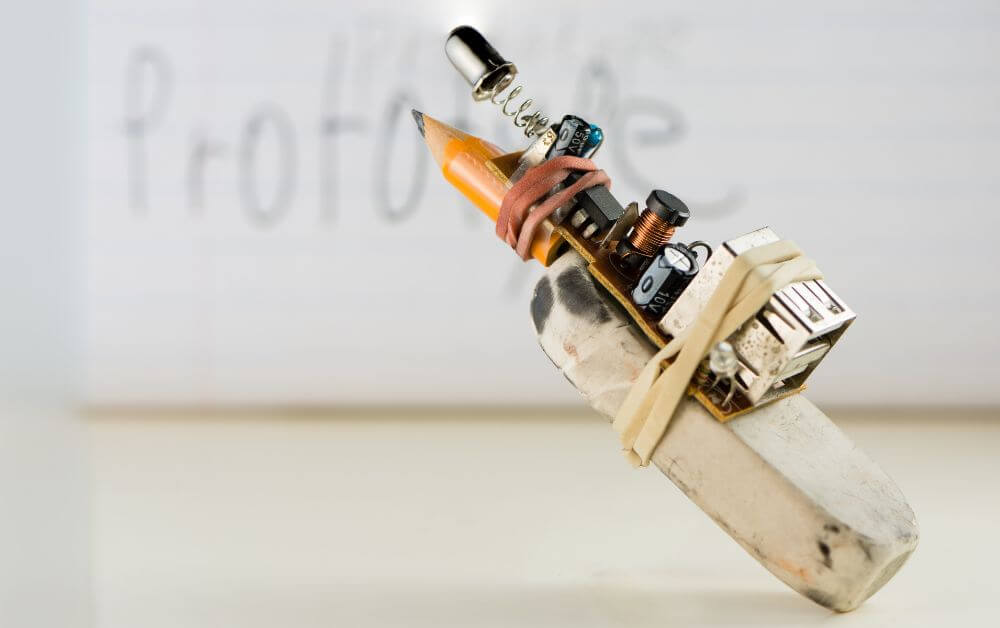If you’ve ever felt overwhelmed by the idea of “innovation,” picturing it as costly, resource-intensive, or overly complicated, you’re certainly not alone. Yet, what if innovation could be as simple – and as quick – as assembling everyday materials in under an hour?
Leaders often view experimentation as a daunting task, involving significant budgets, extensive planning, and advanced technology. However, Tom Chi, the former head of user experience at Google X (a division playfully referred to as Google’s “Department of Science Fiction”), proves otherwise. With just hairbands, fishing lines, chopsticks, and a presentation clicker, Chi and his team built a working prototype for gesture-based software control – in only 45 minutes.
Rapid Experimentation: Simple Steps, Powerful Results.
When developing the early version of Google Glass, Chi asked a crucial question: How long might it take to prototype a headset display? While many expected weeks or months, the first workable model emerged within a single day, fashioned from a bent coat hanger, a plexiglass sheet, and a pico projector.
Just imagine your own team stepping into an innovation session armed with the kind of materials found in a local store or even your office supply cabinet. Chi’s team didn’t just theorise or speculate – they got hands-on immediately. And this act of doing turned out to be far more powerful than hours spent debating around a boardroom table.
While Google Glass didn’t ultimately become a commercial success and the project itself took place over a decade ago, the process behind its development remains a powerful case study in rapid innovation. It’s a reminder that not every experiment needs to succeed for the learning to be valuable, and that’s a hallmark of antifragile teams: they get stronger through what they learn, not just through what they ship.
Fail Quickly, Learn Faster.
What Chi discovered through his playful, low-fidelity prototypes were invaluable lessons that no amount of theorising could have revealed. When his team prototyped gesture-based software interaction inspired by the film Minority Report, they quickly uncovered social awkwardness and ergonomic challenges. By learning what didn’t work, they rapidly adapted and evolved the product effectively, saving valuable resources and guiding better strategic decisions.
This rapid approach embodies TomorrowToday’s principles of antifragility – a concept detailed in our Antifragility White Paper. Antifragile organisations don’t just withstand shocks; they grow stronger from them. Quick experiments allow teams to pivot effortlessly, developing resilience and the agility to thrive in uncertainty.
Expansive Learning vs. Book Learning.
At TomorrowToday, we distinguish between two types of learning. “Book learning” is the knowledge passed down through generations, which, while essential, confines your thinking to what humanity already knows. By contrast, “expansive learning” propels teams forward, pushing into new territories of innovation, discovery, and possibility.
Chi exemplified expansive learning when his Google X team discovered a fundamental ergonomic principle about eyewear comfort using simple clay, paper, and modeling wire. They didn’t just refine Google Glass; they contributed genuinely new insights into wearable technology. Leaders who encourage expansive learning within their teams ignite their collective potential to shape the future.
Creating Your Antifragile Team.
Most businesses think they’re resilient. Few are actually antifragile.
Here’s how to tell the difference: 👇
✅ You invite friction and feedback – even when it’s uncomfortable.
✅ You run experiments weekly, not annually.
✅ You decentralise decisions and trust people to act fast.
✅ You balance psychological safety with radical candour.
✅ You learn more from failure than from success.
If you’re not ticking at least 3 of these boxes, your business might be fragile and you won’t know it until it’s too late.
Chi’s story demonstrates that your team doesn’t need elaborate resources or years of preparation. With intentional action and rapid experimentation, your team can develop the agility and resilience critical to thriving in today’s disruptive landscape.
At TomorrowToday we understand the pressures leaders face.
At TomorrowToday, we understand the pressures leaders face when navigating the uncertainties of the future. Our Antifragility framework, as outlined in our white paper Antifragility in Work and Life, goes beyond just experimentation. It equips leaders with the mindset, tools, and culture needed to thrive in volatility – whether that means running low-fidelity experiments, building adaptive systems, fostering resilient mindsets, or aligning purpose with performance. Like Chi’s prototyping journey, rapid experimentation is one tool in the broader toolkit we offer.
Remember, becoming antifragile isn’t about perfection – it’s about movement, curiosity, adaptability, and the courage to respond creatively to disruption. Innovation belongs to those who are willing to try, to learn, and to lead into the unknown.
Your Next 45 Minutes.
So, what’s your 45-minute innovation challenge?
As you look around your workspace, what quick, resource-light experiment can you and your team conduct right now to tackle a problem or opportunity you’re facing?
Embrace rapid experimentation today, and watch your team become more agile, innovative, and, ultimately, antifragile.
Ready to move beyond resilience and turn disruption into your competitive advantage?
Book our team for our Antifragility Keynote or Workshop, and equip your leaders to confidently navigate uncertainty, thrive through challenges, and build a future-ready organisation.


